 Dark Ages Re-Creation Company
Dark Ages Re-Creation Company

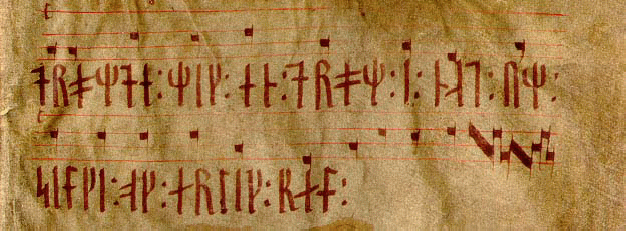
Figure 1: Detail of the Codex Runicus Manuscript, Arnamagnæan Digitization Project
Drømte Mig en Drøm is apparently a familiar piece in Denmark as it was used as theme music on Denmark’s national radio for years. Unfortunately, most of the transcriptions I was able to find did not quite match up with the original. While the basic tune is fairly consistent, there are many interpretations of the timing and thus the feel of this tune as well as a few note issues.
| The Viking Network website, while an excellent resource otherwise, has two major discrepancies. First, although their line drawing reproduction is identical to that of the manuscript, they cite it as being carved in a small piece of wood from the 14th century that was found in Denmark. Secondly, their music is clearly longer than the original. Now it is possible that there is a second source that I’ve never heard of, but the chances of two versions of the same music being the only music found in Denmark for 200 years is next to nil. I suspect their music is a modern variation on the theme. | 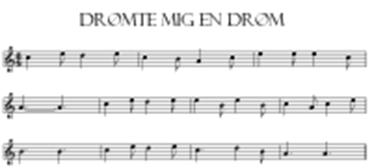
|
| Figure 2: Viking Network version |
| By comparison, the audio file that accompanies the facsimile of the manuscript on the Arnamagnæan Digitization Project website (figure 3) is too short. A couple of notes are deleted from the section with text and the “instrumental” section at the end is missing entirely. |  |
| Figure 3: transcription of the audio file from the Arnamagnæan Digitization Project website. |
I have not yet come across any discussion of the final section of the music where the runes leave off. My skill at reading mensural notation is not good enough to puzzle out the phrase that is squeezed into the end of the second line, but it is clearly a variation on the original theme. My suspicion is that this either was meant to be an instrumental bridge or a short-hand notation for a section that appeared later in the piece (if not the very next line). In my own compositions I occasionally use similar short-cuts in my rough drafts in order to save staff paper.
Appendix B 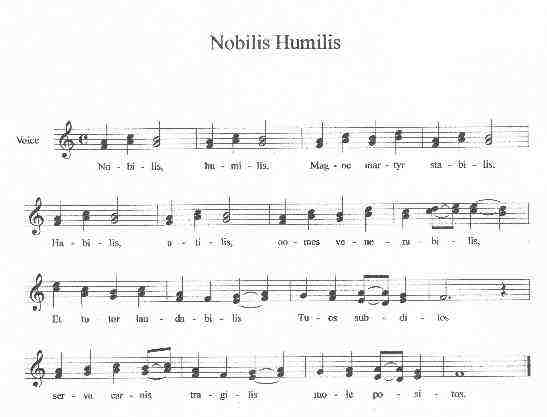
Noble, lowly, Magnus the
steadfast martyr,
able, serviceable,
reverend earl and honoured guardian:
save thy people burdened
with frail flesh [1]
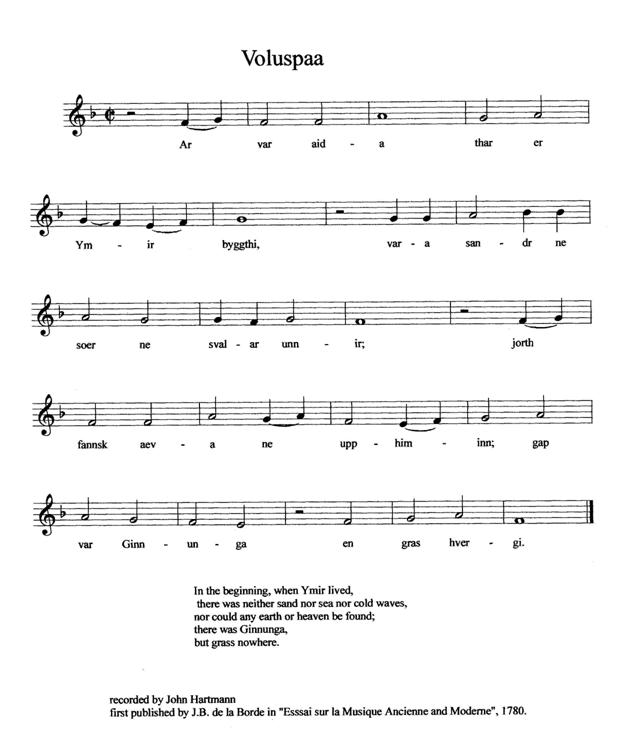
Harald Hardrade’s Song (Hartmann #4)
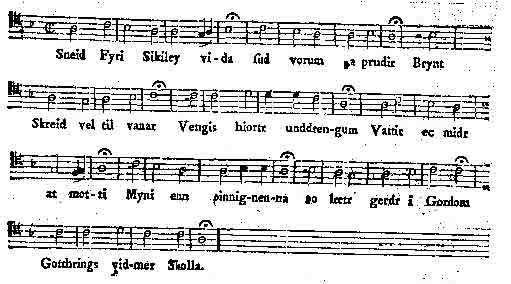
Lilja[2]
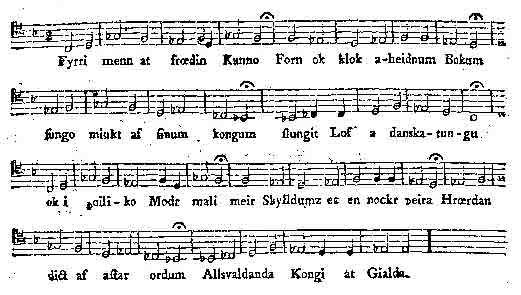
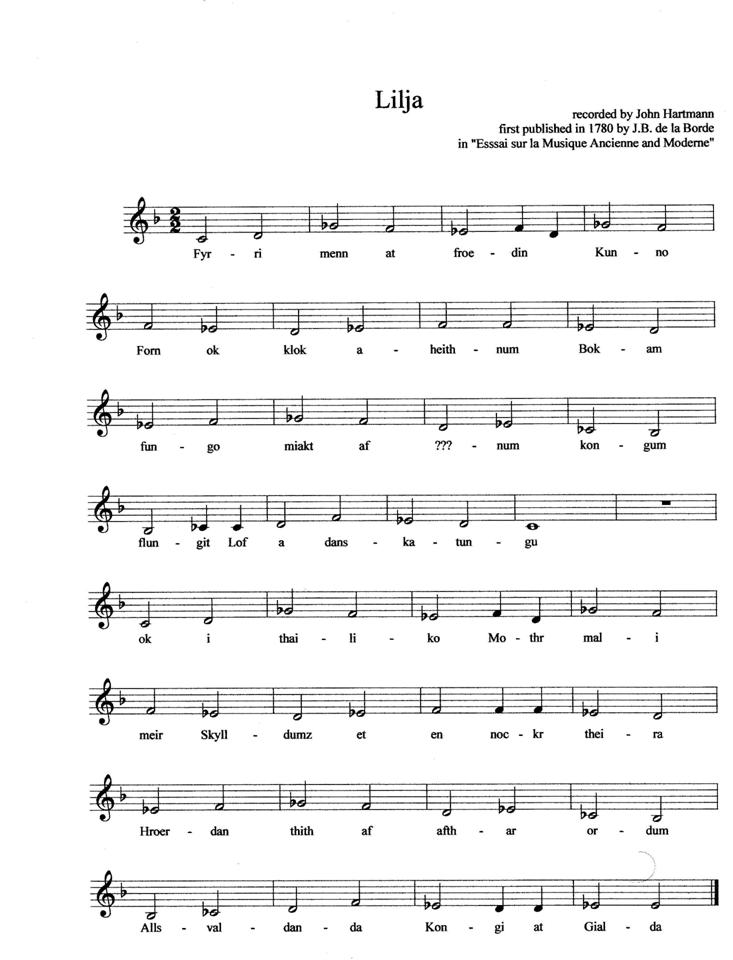

Skammel lived in the north, by
Tyr,
being both rich
and well-reared
Five sons had he, all tall and
proud with two of them
having grown beards.
And
so it is Ebbé Skammelssøn treads on the wild
paths.
The elder was Ebbé
Skammelssøn and Peder was his
brother.
Sorrowful is the tale I sing, how
one did slay
another.
And
so it is Ebbé Skammelssøn treads on the wild
path.
Ebbé wooed gentle
Lucelill and soon he won her hand.
Ebbé took his betrothed
home to live in his mother’s
land.
And
so it is Ebbé Skammelssøn treads on the wild
paths.
Ebbé in search of gold
and fame serves at the court of
the King.
His brother Peder, still at home
courts Lucelill with
a ring.
And
so it is Ebbé Skammelssøn treads on the wild
paths.
“Lucelill, scorn my
off’rings not! My brother cares
little for you
Ebbé serves in the
King’s Own Guard and now has a lady
new!”
And
so it is Ebbé Skammelssøn treads on the wild
path.
“For Ebbé
I’ll wait for eight long years and I will
accept no other.
No one shall win my heart and
love,
far less Ebbé’s
very own brother.”
And
so it is Ebbé Skammelssøn treads on the wild
paths.
But up and spake his mother cruel,
She spoke these
words untrue,
“Take my son Peder
Skammelssøn for Ebbé loves not
you.”
And
so it is Ebbé Skammelssøn treads on the wild
paths.
Fair Lucelil shook her golden
locks
exclaiming, “I
love him still!
When Ebbé returns from
o’er the sea I’ll serve him in
all he wills.”
And
so it is Ebbé Skammelssøn treads on the wild
paths.
“Then I must tell the
naked truth,” his mother to her
replied:
“I would have spared you
Lucelill, but Ebbé at harvest
died.”
And
so it is Ebbé Skammelssøn treads on the wild
paths.
So work did start on the wedding
feast and all did
bake and brew,
While at the court Ebbé
served his King and nothing of
these things knew.
And
so it is Ebbé Skammelssøn treads on the wild
paths.
At midnight
did Ebbé Skammelssøn awake from an evil sleep,
And as he lay trembling in a sweat
foreboding to him
did creep.
And
so it is Ebbé Skammelssøn treads on the wild
paths.
“I dreamt in my tower of
stone the flames licked tall
and wide,
While my brother Peder burned
within beside my very
bride!”
And
so it is Ebbé Skammelssøn treads on the wild
paths.
That same night did
Ebbé
Skammelssøn don armour and
ride away.
So Ebbé came to his
father’s gate all on the wedding
day.
And
so it is Ebbé Skammelssøn treads on the wild
paths.
Outside stood
Ebbé’s sisters two: each held a cup of
gold,
And they bade Ebbé
Skammelssøn to be neither fierce
nor bold.
And
so it is Ebbé Skammelssøn treads on the wild
paths.
So Ebbé was brought
into
the hall unnoticed by all the
rest,
And with every toast to Lucelill
the sadness welled in
his chest.
And
so it is Ebbé Skammelssøn treads on the wild
paths.
As evening came, Lucelill did
stand
to seek out the
bridal bed.
With torch did Ebbé
Skammelssøn as eldest walk at the
head.
And
so it is Ebbé Skammelssøn treads on the wild
paths.
Ebbé did stop the
bridal
train in front of the bower
door.
“Fair Lucelill, did you
forget you were pledged to me
before?”
And
so it is Ebbé Skammelssøn treads on the wild
paths.
“I fear,
Ebbé,
all I swore before is pledged now unto
your brother,
But all the days that I will live
I’ll treat you like
a mother.”
And
so it is Ebbé Skammelssøn treads on the wild
paths.
But underneath Ebbé
riding cloak his broadsword there
did hide.
He drew it and with its flashing
blade did murder his
brother’s bride.
And
so it is Ebbé Skammelssøn treads on the wild
paths.
Ebbé did call to his
brother false: “Leave now the
mead and the wine.
Your bride is calling after you as
in the bed she does
pine!”
And
so it is Ebbé Skammelssøn treads on the wild
paths.
Then up spoke Peder
Skammelssøn and loudly did he
laugh.
He could not see his
brother’s face pale with revenge
and wrath.
And
so it is Ebbé Skammelssøn treads on the wild
paths.
“Listen,” said
Peder Skammelssøn, “And lay your rage
aside.
If you so desire Lucelill to you
I’ll yield the
bride.”
And
so it is Ebbé Skammelssøn treads on the wild
paths.
But as the groom stood to leave
the
hall, mad Ebbé did
strike again.
And greatly the guests did cry
out,
for Ebbé cleft
Peder in twain.
And
so it is Ebbé Skammelssøn treads on the wild
paths.
He dealt his father a fatal blow,
his mother false
lost a hand.
And this is why Ebbé
Skammelssøn the outlaw rides over
the land.
And
so it is Ebbé Skammelssøn treads on the wild
paths.
And so did Ebbé
Skammelssøn jump onto his horse and
ride.
He haunts the forests of Denmark
fair in search of a place
to hide.
And
so it is Ebbé Skammelssøn treads on the wild
paths.[3]
| En
Märkelig Vise om de Söfarne
Mänd
Der bode en konning i Babylon,
Somme
vilde sejle, somme vilde ro,
De gange dennem da ned til strand,
De lagde dennem ud at sejle til
fuld,
"Nu ville vi sejle og fare,
De selje, de selje på bölgen
blå,
Alle vare de söskendebörn for sand,
De lagde dem ned at gräde,
"I tör ikke end ved at gräde,
De toge og bandt ham ved sejlende‑stang,
De toge og bandt ham ved sejlende‑trä,
De skare ud hans lever og lunge, "I
salter det köd og gemmer det vel!
Da kom der en due fra himmelen ned,
Kongen han taled til liden smådreng:
"Jeg er ikke en due, at skyde
händt, "Est du en
Guds engel, som
af går savn,
"Lägger eder hen at sove under
ö!
Så vågned op den förste;
Så vågned op den anden:
Nu er her gläde over alle med
gammen, |
A Wonderful Ballad of the Seafaring Men
In Babylon lived a
king of yore,
Some
would sail, and some would roam,
They
went to the strand with bang and
boast,
They
laid out to sail so bold,
"Now we will sail, now we will
fare,
They sailed and sailed the billows
blue,
All were of the same kin and blood,
They lay down crying and weeping,
Quoth the old mate: "Before you
starve, They
took and bound him to the mast,
They slaughtered him as calf or lamb,
They cut out both liver and lung, "Keep
it yourselves, and salt your meat; There
came a dove from the heavens high Quoth
the young king to his boy so wee: "I am no bird to
be shot for food, "If
thou art a God's angel, as thou
dost tell, "Lay yourselves
down to sleep and rest; Up
awoke sailor the airest:
Up and spoke another:
There was mirth, and there was glee, |
http://www.folk‑network.com/miscellany/markelig.html
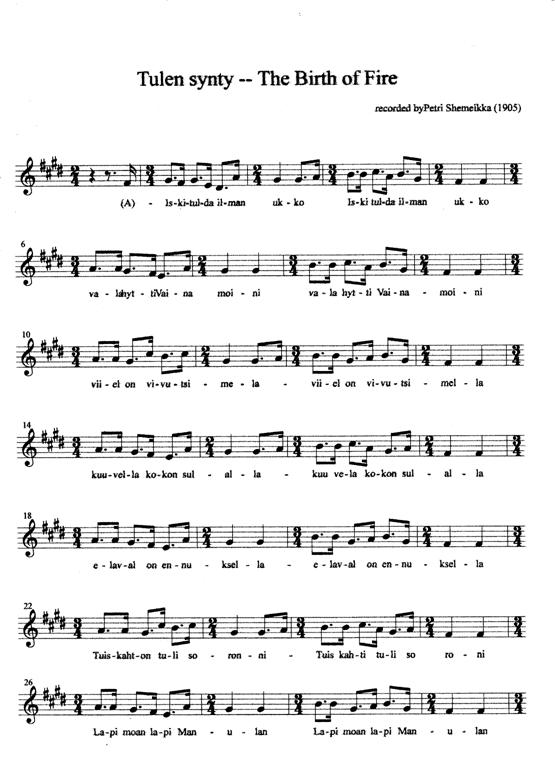
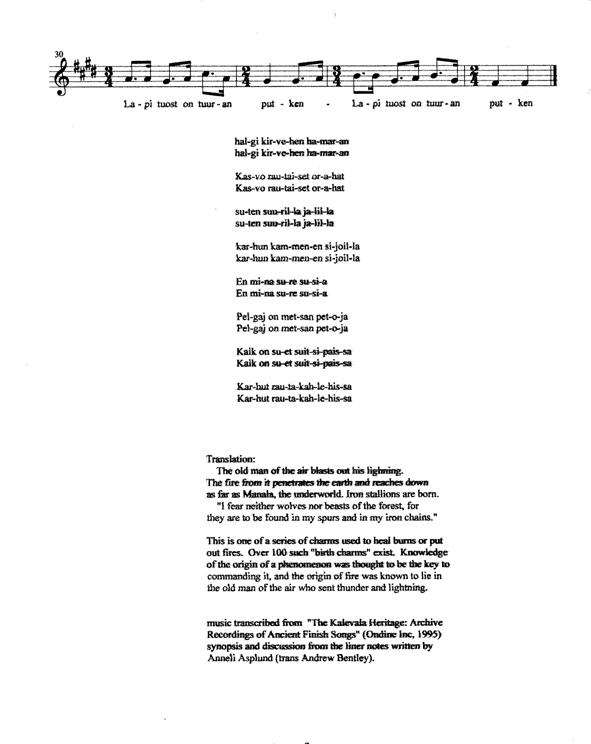
BIBLIOGRAPHY
The
Aksel Schiøtz Anthology of Nordic Solo Songs Vol. 5
Iceland/Faroe Islands. Ed. Gert
Schiøtz. (Edition Egtued Danmark, 1986).
The
earliest songs in this collection are medieval, but still useful in
tracking
musical traditions backwards. Each song is given a little write up as
well as
an English translation.
“Bosi
and Herraud”. Two
Viking Romances. Trans.
Hermann Pálsson and Paul Edwards.
(Penguin Classics: NY 1995).
These
are two very funny little stories (at least from a modern perspective),
but not
ones that I would choose to accurately reflect historical events.
Bruce-Mitford, Rupert and Myrtle.
“The Sutton Hoo
Lyre, ‘Beowulf’ and the
Origins of the Frame Harp”. Aspects of Anglo Saxon
Archaeology. (Victor
Gollanez: London, 1974).
An excellent article on a very
important artefact. It
includes lots of
detailed pictures and
a good explanation of how the
original reproduction (created by the author) went so
horribly wrong.
Garland Encyclopedia of World Music.
Volume 8 “Musical Cultures of Europe”.
(Garland:
NY,
2000).
“Denmark”.
v. 8. pp. 451-458.
Hopkins, Pandora. “Iceland”. v.
8. pp. 400-409.
Leisiö, Timo.
“Finland”.
v. 8. pp. 475-483.
“Norway”. v. 8. pp. 410-424.
Ling, Jan and Erik Kjellberg and Owe
Ronström. “Sweden”.
v. 8. pp. 434-441.
These articles provide a good survey
and include many fragments of music.
The
music is naturally
all medieval and later, but it is helpful to get a sense of what Norse
music
developed into.
Grinde,
Nils. A
History of Norwegian Music.
(University of Nebraska Press, 1991).
This is one of the most useful
sources I came across.
Horton,
John. Scandinavian
Music: A short
history. (Greenwood
Press, 1963).
An excellent text with a chapter
dedicated to the pre‑Christian and Mediaeval periods.
The
Kalevala Heritage: Archive Recordings of Ancient Finnish Songs.
(Ondine: Helsinki, Finland. 1995)
With
many recordings preserved here from their turn-of-the-century wax
cylinder
recordings, this is an invaluable look into Finnish music.
Leahy, Kevin.
Anglo-Saxon
Crafts. (Tempus Publishing: The Mill, Brimscombe Port,
Stroud,
Gloucestershire,
2003)
This is a good broad survey
book.
As he is pulling his
information from many
sources some of the techniques discussed are inaccurate.
Lönnrot,
Elias. The Kalevala: Epic of the Finnish People.
Trans. Eino Friberg.
(Otava Publ. Co. Ltd.: Helsinki, Finland. 1988).
This
is the best translation of this epic poem(s) I’ve found as
far as preserving
the poetic feel and retaining the essential integrity of this amazing
collection
of Finnish oral tradition.
Orkneyinga Saga. Trans. Hermann Palsson and Paul Edwards. (Penguin Books: NY, 1981). Translation first published by Hogarth Press, 1978.
Mainman,
A.J. and Rogers,
N.S.H. Craft,
Industry and Everyday
Life: Finds from Anglo‑Scandinavian York. Volume
17, Fascicule 14 :
The Small Finds
from the Archaeology of York series.
(Council for British Archaeology: York,
2000).
This
is a very detailed look at the smaller artefacts from a very rich
series of
digs. Items are
carefully illustrated to
scale with excellent accompanying text.
A very useful source.
Morris,
Carole A. Wood
and Woodworking in
Anglo-Scandinavian and Medieval York.
(York Archeological
Trust: York,
2000).
A
detailed look at the York
wood collection with six packed pages
dealing with the 4 instrument/instrument fragments that had been found.
New
Grove Dictionary of Music and
Musicians. Ed
Stanley Sadie. (MacMillen
Press: London,
1980).
With
excellent articles for all five of the core Norse countries (Norway,
Sweden,
Denmark,
Finland
and Iceland)
this is a very good source
for a quick summary.
New
Grove Dictionary of Musical
Instruments. Ed.
Stanley Sadie. (MacMillen Press: London, 1984).
“Lur”. Pp. 547-548.
“Kantele”.
Pp. 358-359.
More specific to just the
instruments, this collection is a wonderful resource.
Saemundar
Edda: The Elder or
Poetic Edda.
(Viking Club: London,
1908). reprinted by The
Viking Society for Northern Research.
This is an excellent edition
including side by side translation.
Sanger,
Keith and Kinnaird, Alison. Tree
of
Strings: crann nan teud: A History of the Harp in
Scotland. (Kinmor Music:
Shillinghill Temple,
Midlothian, Scotland, 1992).
A
very detailed piece of research and a great book even though it
doesn’t
actually ever mention the Norse specifically.
Simpson,
Jacqueline. Everyday
Life in the
Viking Age. (B.T. Batsford Ltd: London, 1967).
A good survey book.
Steenstrup, Johannes.
The
Medieval Popular Ballad.
trans. Edward Godfrey Cox.
(University of Washington Press: Seattle,
1968). Originally
published 1891.
Although
dated, Steenstrup was a contemporary of Francis Child and his work was
instrumental in preserving early Scandinavian balladry and still serves
as a
foundation for modern research.
Sturlason, Snorre. Heimskringla: The Norse King Sagas. Trans. Samuel Laing. (J. M. Dent and Sons Ltd: London, 1951)
The Prose Edda. University of California Press, London.
Wallace,
Patrick. A
Guide to the National
Museum
of Ireland. (Town House and Country
House: Dublin,
2000).
The National Museum of Ireland is
one of the better collections I’ve seen.
This Guide only touches on four objects pertinent to this
discussion —
two cast bronze horns from Drumbest and Drunkendult, the Loughnashade
trumpet,
and St Patrick’s bell (and shrine).
WEBSITES
The
Archeology of York
Web Series
"Everyday Life:
Music."
www.yorkarchaeology.co.uk/wgate/main/life3.php
"Panpipes".
www.yorkarchaeology.co.uk/artefacts/panpipes.htm
This
is a very well put together website by a museum with a great many items
of
interest for those studying Anglo‑Scandinavian culture.
The scale drawings and description of the
preservation processes are very neat.
Arnamagnæan
Digitization Project. AM 28 8vo - Codex Runicus.
University of Copenhagen.
Accessed
Oct. 2002.
www.hum.ku.dk/am28.html
A huge project with wonderful
scanned documents, but with little commentary.
Artefacts
Alive!.
York
Archaeological Trust.
Accessed Nov. 2003. www.yorkarchaeology.co.uk/artefacts/aa_frameset.htm
A
very nice discovery site for students that doesn’t talk down
to them and has
very good information.
Brancato,
Paola. Kantele.
http://www.evolusuoni.it/scandinavia/kantele.htm
Brown,
Barnaby. The
Triplepipe. Accessed
Apr. 2004.
www.triplepipe.net
A
nice quick summary with some very
nice pictures.
Butler,
P. The Rebec
Project. Updated October
21, 2003
www.crab.rutgers.edu/~pbutler/rebec.html#1
A
good historical survey with many good pictures and instructions on the
construction of a
rebec.
Carter,
Michael. Some Background Regarding the Glastonbury
Drum. Accessed Aug. 2004.
www.psaltoftheearth.com/glastonburydrumback.htm
Michael
Carter is an instrument maker and retired educator and it sounds like
he’s done
much research, but he doesn’t go into detail here.
The vague references are
frustrating.
Chadwick,
Simon. Anglo‑Saxon Reed Instruments? June
25, 2000.
Accessed Nov 2002.
A well thought out argument in an
area with little information.
(Note: This article is no longer
posted on his website, but can still be obtained by contacting
the author directly)
Drapa
Niflunga (The Slaughter of the Niflungs). Poetic
Edda. Trans
Benjamin Thorpe. Accessed
Apr. 2004.
www.stavacademy.co.uk/mimir/poetict.htm
Follett, Christopher. Fascinating Glimpse of Viking’s Elite Lifestyle: Original seventh century Viking manor house building unearthed west of Copenhagen. The Copenhagen Post. January 24, 2003.
Gjetmundsen,
Kjetil. Norwegian Folk Music.
http://home.online.no/~kgjetmun
Excellent description of half a
dozen instruments and their histories.
Gustafsson‑Dock,
Katarina. Drømde
mik en drøm: En
bakgrund till musiklivet på Foteviken under vikingatid och
medeltid. Museum
of Foteviken. Accessed Sept 2004.
http://www.foteviken.se/art_50_99/viking_art61.htm#viking
Very
frustrating as it looks like a great source, but while parts of the
site are
available in English, this research is only in Swedish.
Gohring,
Bill and Janet. History
of the Jew’s
Harp. Accessed
Aug 2004.
www.jewsharpguild.org/history.html
Hurstwic
(a living history society in New
England). 2001‑2002.
http://www.hurstwic.org/history/articles/literature/text/music.htm
Not bad research, but not complete.
Lie,
Kare A. The Songs of the Vikings.
2001.
http://www.lienet.no/Vikings.htm
Lie
is a Norweigan translator and author who speaks over a dozen
languages. His website
provides a good survey of the
music sources, but only talks about the lyre in discussing instruments.
Living
History 400‑1100 Forum. Sept
1999‑Oct
2002.
C. L.
Ward
Thu
Sep 23 1999
Carolyn
Priest‑Dorman
Thu Sep 23 1999
Gunnora
Hallakarva
Tue May 23 2000
Catherine
Stallybrass
Sat Oct 19 2002
http://www.livinghistory.co.uk/400‑1100/forum/xw_117.html
Interesting
discussions, but mostly
useful for directing to other sources.
Miettinen,
Jarno. History
of Jew’s Harp in
Finland. Accessed Aug 2004.
www.freewebs.com/munniharppu/english/history.html
A good focused essay, but only one
source of information is
cited.
Musica
Romana:Instruments of Antiquity. Accessed October,
2004.
www.musica-romana.de/en/instrumente2-e.html
A
brief survey of ancient instruments from a group of musicians
interested in experimental
archeology. Well
written although
lacking in documentation.
Norwegian
Traditional Music and Dance Association. Accessed Dec. 2003.
http://www.folkogdans.no/main_eng/
Good
images of
a few of the traditional instruments with a bit of their history.
Panpipe
or Syrinx.
Accessed June 2004.
http://users.pandora.be/avvakum/ancient/linkse.html
From
a series of short pages dealing with aspects of ancient music developed
from a
paper the author wrote at the University of Ghent. The
research, bibliography
and links are good
even if the English is a little rough in spots and the author is
elusive
(Kris Swente? aka S.W. Eaty)
Parrish,
Vicki and Robinson, Michael. Giraldus Cambrensis.
http://www.standingstones.com/giraldus.html
These
two Celtic musicians have done an excellent job with their research on
this 12th
century cleric. What's
especially nice
is the side by side translation of the Giraldus' writings on Irish and
Welsh
music.
Paxson, Diana. www.hrafnar.org/seidh.html
Priest‑Dorman,
Greg and Carolyn. The Saxon Lyre: History, Construction, and Playing
Techniques. 1992, 1995.
http://www.cs.vassar.edu/%7Epriestdo/lyre.html
The
article deals more with construction than history, but it's a good
summary and
they do include a bibliography.
Rahkonen,
Carl. The Kantele Traditions of Finland.
2003
http://www.people.iup.edu/rahkonen/kantele/history.htm
Taken
from his doctoral dissertation on the Finnish kantele, this is an
expert and
focussed article, but unfortunately his endnotes were not included.
Ramskou,Thorkild.
Music Blown on Lurs From
the Danish Bronze
Age.
www.chem.au.dk/~metcat/TheLurs.html
Republished
on this company website, the article lacks a bibliography, but is a
good
summary on the Bronze Lur.
Saha,
Hannu. “The
instruments of the Kalevala
culture”. (Virtual Finland:1999).
http://virtual.finland.fi/finfo/english/folkmus4.html
Accessed Aug 1, 2006
No references, but a nice concise
article written by an expert in the field.
Seglem,
Karl. "Recordings of historical interest".
FolknettNorway: The
Guide to Norweigian Folk Music.
http://www.fono.no/folknettnorway/about%20the%20music.htm
A good survey, but no references.
"The
Ship in Distress" in Scandinavia.
Reprint
of “En Märkelig Vise om
de Söfarne Mänd”
a small tract, printed by Professor
Svend Grundtvig originally appearing in The Folk‑Lore
Record,
Volume III part II, 1881. Accessed
December 2004.
http://www.folk‑network.com/miscellany/markelig.html
This is a short piece on a single
song, but with good side by side
translation.
The
Sigurd Portal. February 4, 2000.
http://www.pitt.edu/~dash/sigurddoor.html#photographs
Mostly useful for its clear
photographs.
Towrie,
Sigurd. “Norn ‑
the Language of
Orkney.”Orkneyjar--the heritage of the Orkney
Islands.
www.orkneyjar.com/orkney/norn_scott.htm
Accessed February, 2006
A
private website but well put together with interesting facts about the
Orkneys
(although with very little about music specifically).
Viking Age Music. Accessed May 2004.
Pertout,
Adrian. The
Jew’s Harp: At the Dawn
of the New Millennium. Originally published in Mixdown
Monthly,
issue #68, Dec. 1999. Accessed
Aug 2004.
www.users.bigpond.com/apertout/Jew’sHarp.htm
A broad survey with a good
bibliography, but it lacks details.
Preston,
Cathy
Lynn. A
‘Working’ KWIC Concordance to Francis James
Child’s The English and Scottish Popular
Ballads
(1882-1898). University
of Colorado. Accessed Aug. 2004.
www.colorado.edu/ArtsSciences/CCRH/Ballads/ballads.html
On-line source for Francis Child’s famous
collection.
Seglem,
Karl. "Recordings of historical interest".
FolknettNorway: The
Guide to Norweigian Folk Music.
www.fono.no/folknettnorway/about%20the%20music.htm
A good survey, but no references.
www.threeleos.com/glastonburydrum.html
Interesting suggestion, but no
backing evidence.
http://tns‑www.lcs.mit.edu/harp/archives/1995.08/0123.html
Open
discussions are always suspect, but there are some knowledgeable people
on this
list.
The
Viking Network
Friis, Mogens.
Vikings and their Music. April 2000.
Ragnarsson,
Hjálmar H.. Viking
music on Iceland
from
"A Short History of Icelandic Music to the Beginning of
the
Twentieth CenturyMUSIC " (masters thesis, Cornell University,
1980)
Types of Viking Music
http://viking.no/e/life/music/e‑musikk‑mogens.html
A
very good source of information. The
page on Types of Viking Music is vague and unsubstantiated, but the
others are
good and there are excellent photos of the instruments.
Ward,
Christie (Gunnvör
sílfrahárr).
Viking Age Music.
Accessed May, 2004.
www.vikinganswerlady.com/music.htm
A
very well researched paper and an excellent survey even though she
claims it is
still a work in progress.
Williamson,
Roland. Music and Verse. Regia Anglorum Publications.
February 2000.
www.regia.org/music.htm.
Though focused more on Anglo‑Saxon
music, the essay is a decent survey.
Wooden
pipe find excites Irish archaeologists.
ABC
Online. May 10, 2004.
Accessed May
2004.
www.abc.net.au/news/newsitems/s1105308.
www.vikingsandsaxons.com. December 7, 2003.
Accessed Nov 2003.
An
on-line artefacts dealer. I
can’t vouch
for their research, but they have very pretty things for sale for more
money
than I have.
[1]Horton, John.
Scandinavian Music: A short history. Greenwood Press, 1963. pp. 20‑21
[2]Lie, Kare A. The Songs of the
Vikings. 2001. http://www.lienet.no/Vikings.htm
first published in J. B. de la Borde's Essai sur la musicque ancienne et moderne (1780)
[3]This version is copyright by Shelly
Rabinovitch, based on translations by R.C. Prior, A. Olrik, and S. Straubharr.